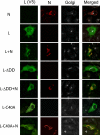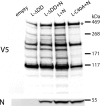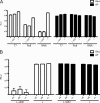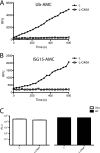Crimean-Congo hemorrhagic fever virus-encoded ovarian tumor protease activity is dispensable for virus RNA polymerase function
- PMID: 19864393
- PMCID: PMC2798392
- DOI: 10.1128/JVI.01859-09
Crimean-Congo hemorrhagic fever virus-encoded ovarian tumor protease activity is dispensable for virus RNA polymerase function
Abstract
Crimean-Congo hemorrhagic fever virus (CCHFV) is a tick-borne virus (genus Nairovirus, family Bunyaviridae) associated with high case fatality disease outbreaks in regions of Africa, Europe, and Asia. The CCHFV genome consists of three negative-strand RNA segments, S, M, and L. The unusually large virus L polymerase protein and the need for biosafety level 4 (BSL-4) containment conditions for work with infectious virus have hampered the study of CCHFV replication. The L protein has an ovarian tumor (OTU) protease domain located in the N terminus, which has led to speculation that the protein may be autoproteolytically cleaved to generate the active virus L polymerase and additional functions. We report the successful development of efficient CCHFV helper virus-independent S, M, and L segment minigenome systems for analysis of virus RNA and protein features involved in replication. The virus RNA segment S, M, and L untranslated regions were found to be similar in support of replication of the respective minigenomes. In addition, the OTU domain located in the N terminus of the expressed virus L protein was shown to be a functional protease. However, no evidence of L protein autoproteolytic processing was found, and the OTU protease activity was dispensable for virus RNA replication. Finally, physiologically relevant doses of ribavirin inhibited CCHFV minigenome replication. These results demonstrated the utility of the minigenome system for use in BSL-2 laboratory settings to analyze CCHFV biology and in antiviral drug discovery programs for this important public health and bioterrorism threat.
Figures







Similar articles
-
Independent inhibition of the polymerase and deubiquitinase activities of the Crimean-Congo Hemorrhagic Fever Virus full-length L-protein.PLoS Negl Trop Dis. 2020 Jun 4;14(6):e0008283. doi: 10.1371/journal.pntd.0008283. eCollection 2020 Jun. PLoS Negl Trop Dis. 2020. PMID: 32497085 Free PMC article.
-
A virus-like particle system identifies the endonuclease domain of Crimean-Congo hemorrhagic fever virus.J Virol. 2015 Jun;89(11):5957-67. doi: 10.1128/JVI.03691-14. Epub 2015 Mar 25. J Virol. 2015. PMID: 25810550 Free PMC article.
-
Stable Occupancy of the Crimean-Congo Hemorrhagic Fever Virus-Encoded Deubiquitinase Blocks Viral Infection.mBio. 2019 Jul 23;10(4):e01065-19. doi: 10.1128/mBio.01065-19. mBio. 2019. PMID: 31337717 Free PMC article.
-
Crimean-Congo Hemorrhagic Fever.Lab Med. 2015 Summer;46(3):180-9. doi: 10.1309/LMN1P2FRZ7BKZSCO. Lab Med. 2015. PMID: 26199256 Review.
-
Crimean-Congo hemorrhagic fever.Antiviral Res. 2004 Dec;64(3):145-60. doi: 10.1016/j.antiviral.2004.08.001. Antiviral Res. 2004. PMID: 15550268 Review.
Cited by
-
Crimean-Congo hemorrhagic fever virus nucleocapsid protein harbors distinct RNA-binding sites in the stalk and head domains.J Biol Chem. 2019 Mar 29;294(13):5023-5037. doi: 10.1074/jbc.RA118.004976. Epub 2019 Feb 5. J Biol Chem. 2019. PMID: 30723154 Free PMC article.
-
Independent inhibition of the polymerase and deubiquitinase activities of the Crimean-Congo Hemorrhagic Fever Virus full-length L-protein.PLoS Negl Trop Dis. 2020 Jun 4;14(6):e0008283. doi: 10.1371/journal.pntd.0008283. eCollection 2020 Jun. PLoS Negl Trop Dis. 2020. PMID: 32497085 Free PMC article.
-
Dugbe virus ovarian tumour domain interferes with ubiquitin/ISG15-regulated innate immune cell signalling.J Gen Virol. 2013 Feb;94(Pt 2):298-307. doi: 10.1099/vir.0.048322-0. Epub 2012 Nov 7. J Gen Virol. 2013. PMID: 23136361 Free PMC article.
-
The Structure and Immune Regulatory Implications of the Ubiquitin-Like Tandem Domain Within an Avian 2'-5' Oligoadenylate Synthetase-Like Protein.Front Immunol. 2022 Jan 4;12:794664. doi: 10.3389/fimmu.2021.794664. eCollection 2021. Front Immunol. 2022. PMID: 35058932 Free PMC article.
-
The N terminus of Andes virus L protein suppresses mRNA and protein expression in mammalian cells.J Virol. 2013 Jun;87(12):6975-85. doi: 10.1128/JVI.00043-13. Epub 2013 Apr 10. J Virol. 2013. PMID: 23576516 Free PMC article.
References
-
- Andersson, I., M. Simon, A. Lundkvist, M. Nilsson, A. Holmstrom, F. Elgh, and A. Mirazimi. 2004. Role of actin filaments in targeting of Crimean Congo hemorrhagic fever virus nucleocapsid protein to perinuclear regions of mammalian cells. J. Med. Virol. 72:83-93. - PubMed
Publication types
MeSH terms
Substances
LinkOut - more resources
Full Text Sources
Other Literature Sources

